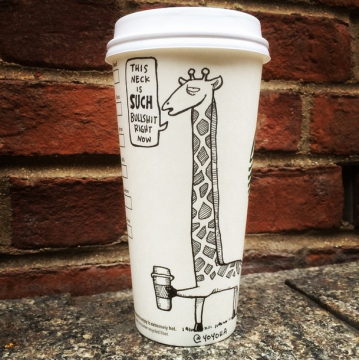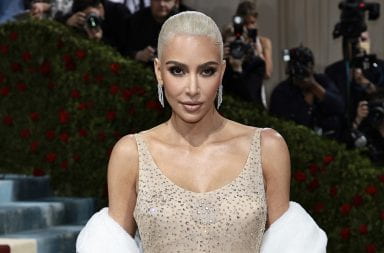Starting the day with a cup of coffee is a common routine, and once the beverage is consumed, many coffee drinkers tend to toss the empty paper cups into the garbage.
But Joshua Hara, creative director at marketing agency Resource Ammirati, has other things in mind.
Hara uses the cups’ blank space as a canvas for cartoons, a practice that started last February. He named this project “#100CoffeeCups” and shares his drawings on his Instagram account, @yoyoha, with more than 66,000 followers, as of Wednesday evening.
“I drink a venti Starbucks coffee every single day,” Hara said. “I had an idea for a cartoon about a barista asking how to spell somebody’s name. I thought that doing that cartoon on the cup would be much funnier. People liked it so much that I did it a few more times. I thought, ‘Well that was fun.’”
Hara studied illustration at the Columbus College of Art and Design. As a reader of classic comics such as “Calvin and Hobbes” and “Garfield” growing up, Hara said he wanted to be a cartoonist as a child. But although he fancied illustration, he felt it was not a steady occupation.
“Even though I loved cartooning, I didn’t see it as a real career path because I was very much aware of how competitive and hard it was,” Hara said. “I went into graphic design after I graduated from CCAD — it was a more practical decision. I know I can still be creative everyday and make money doing it without having to work as a busboy somewhere or in a coffee shop and constantly chasing this very hard dream.”.
Hara said he and those around him saw real potential in his coffee cartoons after completing a few prototype cups.
“I saw an opportunity after the third of fourth cup I did,” Hara said. “A few people who I really respect — other comedy writers on Twitter, friends and people at work — immediately saw the potential and thought it was really unique.”
The hashtag “#100CoffeeCups” was Hara’s co-worker’s idea.
“One of the other creative directors here said (you should call it) ‘#100CoffeeCups’ and you should do 100 of them. To me at the time, because of my work schedule and because I don’t always have time to do things on the side, 100 was an approachable amount of cups that I could probably do by the end of the year,” he said.
Hara’s wife, Halle, said the social media outlet allows her husband to easily reach a vast audience and share his work with ease.
“I’m just so happy for him because he has gotten a lot of attention for it,” she said. “When we first met, he would draw in his sketchbook and show his friends, so not a lot of people were seeing the great work he’s doing. Now that there’s publicity for it, he finally has an audience for his cartoons through social media.”
Hara’s work has caught the attention of media outlets such a Buzzfeed and Mashable, both of which have featured his illustrations.
Nate Beeler, the editorial cartoonist for The Columbus Dispatch, said the combination of a dynamic image with a clear point of view about what the creator thinks is what makes a great cartoon.
“With any arts, the rich and creative drawing grabs the reader’s attention right away. It doesn’t have to be cluttered, it can be subtle — as long as it visually serves its purpose.
“Readers like a visually resting image,” Beeler said.
Beeler added that in the case of cartoon illustrations, the tool of humor keeps the reader engaged.
“A humorous illustration can keep people more engaged than images that are just bland,” he said. “I think humor is a way of cutting through to people’s apathy.”
The content of Hara’s cartoons tend to poke fun at the coffee culture or trending topics.
“I think my obsession with caffeine is definitely the lead story I go to quite a bit,” he said. “It enhances the purpose of it being on a cup. Aside from that, it’s popular culture and what’s happening today.”
Hara said a timely joke is much more powerful than an everyday joke. He said if he has the time to knock out a cup during the peak of a current event, he tries to encapsulate the event everyone is talking about. For example, during the Kim Kardashian “#BreakTheInternet” buzz, Hara drew and posted a parody on Instagram featuring a barista balancing a coffee cup on his derriere while pouring coffee over his head and into the cup. The post was captioned “Caffeinating The Internet” and received more than 5,500 likes and 500 comments.
Each cup takes Hara anywhere between one to two hours to complete, though some can take as little as 15 minutes. The size and curved surface of the cup is an obstacle Hara faced, however, the limited space is also a benefit in his eyes.
“It’s definitely not without its challenges. Because of the curvature and because I can’t make it as perfect as I want, it’s less about the perfection of the drawing and more about trying to do something creative everyday, trying to do something fun, and entertain people,” he said. “The cup almost gives me permission for it not to be perfect.”
Beeler agreed and also thinks the cup’s rounded surface seems challenging.
“I’ve never myself thought of using coffee cups as a canvas because it doesn’t seem like the largest space to work with as an artist,” he said.
Ultimately, Hara managed to meet his goal just in time, finishing his 100th cup on New Year’s Eve.
But he didn’t not stop there. He’s now extended the “#100CoffeeCups” goal into 2015.
Hara is still in possession of each cup that is documented on his Instagram page.
“Everything on Instagram is actually just at my house in a waterproof tub and stacked on top of each other. I am saving them. There definitely has been some interest in doing a book of them so I am just trying to keep them in good shape,” he said.
Halle Hara said she leaves all the creative decisions to her husband and will support whatever path he chooses.
“I told him whatever he wants to do with them is his choice,” she said. “He’s thinking about looking into printing a book of them or manufacturing them into cups in terms of travel mugs people can use. It’s his vision so wherever he decides to go with it, I’ll support him.”














